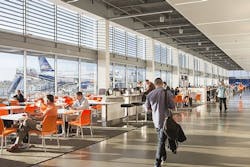Airports apply technology to maximize hospitality
Imagine receiving a notification on your smartphone 24 hours before a flight prompting you to check in and alerting you about the weather forecast and traffic congestion. In the hours leading up to the flight, you continue to receive alerts about valuable information ranging from the least crowded parking lot to the fastest route to your gate. Inside the terminal, biometric identifiers enable you to breeze through a single checkpoint.
Once there, the relaxed ambience and luxurious gate amenities make you feel like you’re in an upscale hotel lobby. You kick back in a comfortable chair and call up an app on your smartphone to order a locally sourced, made-to-order salad. After lunch, you move to a nearby, Wi-Fi enabled work pod for some peace, quiet and heads-down work until your flight is ready to board.
This is the emerging future of flying—a stress-free, well-designed guest experience from start to finish. Airport terminal designers can help airports and airlines elevate their facilities and prepare for this technology-enhanced future.
Technology hubs and iPad bars throughout the Long Beach Airport terminal provide passengers with access to free wi-fi.The Empowered Passenger
Providing passengers with information and helpful tools empowers them. Just as importantly, it reduces stress before they arrive and while they are in the terminal.
Several airports offer passengers virtual walk-throughs of public interior spaces using Google Street View and Indoor Google Maps. Real-time dynamic and interactive displays can alert passengers about overcrowding and facilitate efficient wayfinding. Beacons can provide passengers with information regarding their locations, enabling dynamic wayfinding applications to help travelers find gates.
Terminals that incorporate new technologies offer a more relaxing passenger experience that ultimately has significant benefits for airports. According to JD Power’s North American Airport Satisfaction Survey, for example, passengers that feel high levels of satisfaction at an airport spend up to 45 percent more money in retail shops.
Terminal Layout
Taking a comprehensive approach to terminal design can help airports and airlines adjust to tech-savvy passengers and encourage customer loyalty. Multidisciplinary design teams need to work together to develop terminals that are flexible to adjust as technology evolves.
At the Indianapolis International Airport Col. H. Weir Cook Terminal, fixed elements—including elevators and mechanical shafts—are organized in neat bands. Other spaces including waiting rooms, concessions and restrooms can be moved or scaled to accommodate new demands. Airlines, for example, may need to incorporate additional kiosk space as self-service check-in and baggage check become more common.
In the not-too-distant future, most passengers will check-in via a mobile device and use home-printed or permanent baggage tags. At other airports, baggage will be checked in remotely – further reducing space requirements in airport check-in halls. The challenge and opportunity will be how to best repurpose this space in existing airports and create new airport check-in halls that are flexible enough to incorporate these new trends.
For now, many airlines and airports are working to improve the baggage drop experience. EasyJet has been testing a bag drop system fueled by Phase 5 Technology at its Gatwick hub. The average passenger currently requires 76 seconds to process but the goal is 45 seconds. A new permanent bag tag system, eTag and eTrack, introduced by Air France-KLM and Delta Air Lines will further reduce processing times, queues, and space requirements by eliminating the need to tag bags at the airport. It also allow passengers to track luggage on their smartphones.
Data Sharing and Alerts
The emergence of real-time data technology enables designers to enhance the travel experience and help airports prepare for crowds.
A passenger biometric, captured at check-in or registration prior to travel, could eliminate the need for passengers to show identification multiple times at check-in, emigration, security screening and boarding.
The new Hamad International Airport in Doha, Qatar, features a number of automated border control (ABC) eGates, which use biometric identifiers such as facial, iris and fingerprint recognition technology. Image credit: Vision Box
According to research by FlightView, a real-time flight tracking and research company, 84 percent of travelers want personalized mobile travel information from airlines. Wi-Fi and beacon systems can aggregate passenger information so apps can then communicate with travelers and staff. At Helsinki Airport, new technology will begin tracking passengers from the moment they log into airport Wi-Fi. Airport personnel can then pinpoint long lines and adjust accordingly, keeping passengers apprised of queue lengths via mobile updates.
With the potential for technology to speed up the process and reduce queues, designers will have the opportunity to repurpose underutilized space within terminals. With less congestion, airports may be able to avoid costly expansion through more efficient use of existing terminal space.
Enhanced Amenities
Many airports are already creating new gate areas that incorporate higher quality food and retail options. The next step will be to allow travelers to pre-order food for quick pick-up or to have essential supplies such as aspirin, headphones and books delivered directly to their gates.
For HOK’s Long Beach Airport Modernization, the red lounge seats, fire pits, wine bar, palm trees and garden walkway in the outdoor plaza make guests feel like they are in a resort.
Enabling passengers to use their own smart devices for these services will improve the passenger experience and reduce the need for costly infrastructure. Triangulation similar to GPS technology, or beacons, will make it possible to locate passengers who have placed orders for goods. Designers can help by creating comfortable, relaxed, hotel lobby-like settings that encourage passengers to order food, browse retail offerings and interact.
In the future, all terminal gates will have the enhanced amenities previously only available in club rooms or frequent flyer VIP areas. As airports embrace the revenue generation potential of these hospitality-inspired amenities, designers can ensure that this approach becomes the baseline.
This article originally appeared in the Passenger Terminal World 2015 Showcase.
About the authors:
Robert Chicas is a director of Aviation + Transportation at HOK.?
Richard Gammon is a director of Aviation + Transportation at HOK.?
Al Lyons is director of IT + electronic systems for HOK’s global engineering group.

